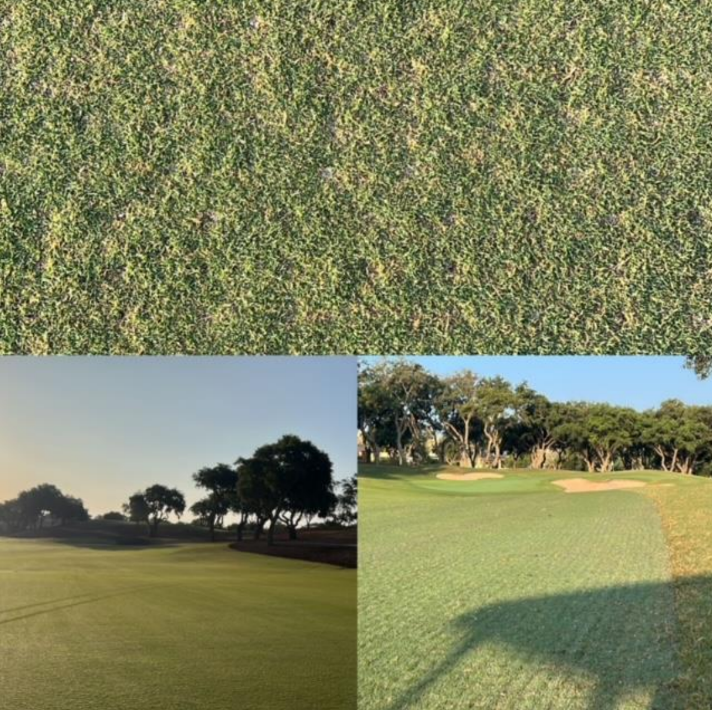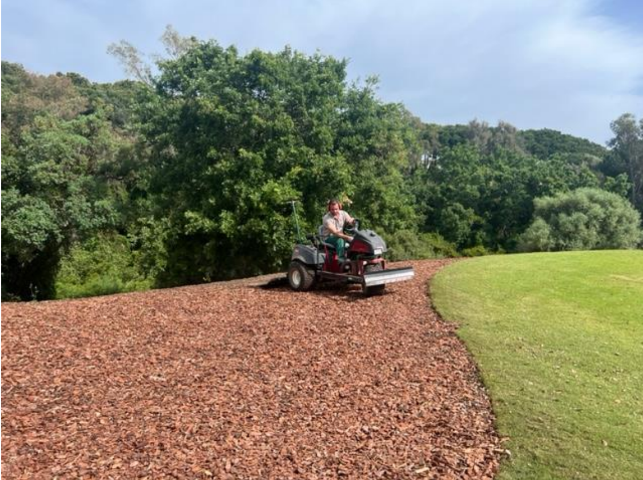Dear Member,
As we’re getting to full recovery after our first closure period, I wanted to update you on the work achieved and look ahead to the next one. Whilst the surface looks fine and we wonder why these are necessary it is important to understand the reasons and importance of these works to ensure long term health and playability. What is happening under the surface is what you don’t see and this has significant importance to the surfaces themselves.
Greens, Ante Greens & Tees – (Bentgrass)
The Bentgrass recovery from the renovation has been slower than I would have liked but considering the aggressiveness of the works, this is understandable. The plan changed on how we cleaned these up which meant a little more surface disruption which is a main factor in the slower recovery. This level of aggression in a small window isn’t advised but given our increasing organic layer and optimum growing conditions it was something we had to commit to. The bigger this layer gets the more it disconnects the surface to the roots and root depth and mass decrease which promote a weaker plant, a weaker plant is what we don’t wont as when we have to do aggressive maintenance the plant isn’t strong enough as it delays recovery.
We managed to achieve our planned range of organic removal; this was 12.78% of the surface area. This was achieved with a double scarification and a 16mm hollow tine.
Below is a picture of 18 green in 2021 and a picture from June 2023 from the same green. The area above the red line is what I am referencing when I mention organic matter. Having some organic matter is very important but ensuring it has managed as it accumulates is crucial.

JUNE 2023
Below shows a loss of ignition test from April this year. We are at 4.6% in the top 20mm and that’s creeping down into the 20-40mm area which is concerning. Our target range for our surface expectation and grass species should be the lower 2-2.5% or anywhere under 3 is acceptable. The challenge we have climatically and seasonally is when it’s that the optimum
time for bent recovery it’s also peak season for the golf business, due to this August to end of October we aren’t able to do any aggressive works so our OM layer accumulate. This is why additional dates in July and the end of August have been included this year. The key with OM control is to keep on top of it as it accumulates through removal and dilution of sand. This didn’t happen in the golf courses most critical stage, around the high nitrogen inputs as the plant established in its first 12 months.

Looking ahead to the July closure, we are going to adjust our original plan to incorporate a double 10mm solid tine to have smaller holes, even if there is more of them it will promote a faster recovery. The future organic matter strategy will need addressing and dates fixing in the calendar. The difference with May, it’s the optimum time for the recovery where growth potential (a temperature-based model which we use to help us make agronomic decisions) is at its best around 0.8-0.9 and July this is down to 0.3-0.4. We would prefer the closure to be in September or October but this isn’t viable due to a busy golf course so July has been chosen as the date to do it.
The management of the OM layer interlinks into so may facets of the turfs processes. It’s directly linked to root depth and mass, irrigation, nutrient and chemical uptake and efficiency.
From a performance standpoint it is also significantly linked to surface smoothness, firmness and speed.
The tees we managed a double 16mm hollow tine which removed slightly more OM at 16.08%.
Tees have a bigger issue than the greens and this is down to differing sand that percolates slower, meaning it retains moisture and nutrients more easily. The other reason for the additional OM is more nitrogen applied to get these recovered in busier periods. The tees plan will be more aggressive than the greens in July with this in mind.
We have completed three sets of nematode tests in the last 6-8 weeks and each of those have shown a reduction in numbers which is positive, our testing frequencies have increased
considerably this year as we try and gain better understanding on the different nematodes and their individual cycles and movements within the profile to ensure our chemical applications are being targeted at the correct time and getting to the correct area where the parasite is.
Whilst these are important points to note and understand regarding the long-term health, requirement for maintenance and control of this organic layer. All is understood and the strategies are in place to ensure the surfaces you will be playing on will continue to be at the highest level.
A couple photos in April and May with the greens presenting well.


This was then followed by a 16mm hollow tine, cleaning the material, topdressing, brushing, rolling to restore surface levels and granular fertilizer.

Double 16mm hollow tine of the tees followed by cleaning, topdressing, rolling and granular fertilizer.

First few cuts were done in the afternoons due to sticky Levante mornings making it troublesome with the sand

Fairways and Roughs (Bermuda)
The Bermuda turf has continued to improve when comparing it to previous years. The closure works were very positive and the recovery was good, weed outbreaks are still evident, especially around the tees and bunkers where the pre emergent is very dangerous to achieve.
Organic layers within the bermuda are under control, the big difference between the bent and the bermuda is bentgrass will accumulate organcic all year round in this climate, whereas bermuda grass doesn’t.
That said it is still important to stay on top of it as we go long periods without the thatch removal so the light verticutting and topdressing is important to maintain the firmness and smoothness.
As touched on in my last report regarding the turf patches, the results came back from the university of georgia where the patches were profiled against 8 other bermuda cultivars and the seperately tested against the lattiude 36, the chosen grass for our fairways and roughs. The DNA profiling confirmed that the patches are not lattitude 36. This is now being discussed with the supplier to formalise a plan of action.

Another photo highlighting the different grass species.

Spring dead spot was worse this winter and this is recovering now, our trials on the front half 8 fairway were very successful and this will be replocated across all areas this fall to prevent the soil borne fungi activating. All data around this years trial is recorded so we can replicate this for the best chance of success. Targetting soil borne pathogens sucessfully can be difficult with many variable factors to consider.
July we’ll be doing a reduced amount of maintenance to the bermuda in comparison to May, we will look to scalp the rough down to try and even it out, still very evident on the areas that were turfed vs sprigged in the renovation. All bermuda will be hollow tined and topdressed, it is important to remember this is the last aggressive works until May/June next year so again which is why the works are necessary.
A few photos of the maintenance we completed in May.
Organcic removal and cleaning processes

Topdressing and dragging

Pictures 14 days on from the works showing good recovery.

A few images 3 weeks on from opening showing good recovery on the bermuda.

Other works
Another big project during the closure was the well documented, problematic, hard bunkers. As touched on this wasn’t the level of the sand it was the moisture content within the sand. Once we emptied the bunkers it was very evident this was the issue. The silt had built up preventing water penetrating through the better Billy bunker therefore the sand moisture was backing up and creating an anerobic environment. This was then washed clean to allow water out the base of the bunker. Bunkers on 4,13,14,15,16,17,18. After washing you could physically see the water going into the drains again and now the bunkers are back to playing how they should be.
We also took the time to replenish the sand and move levels around.

The team continue to replenish the mulch areas to improve the aesthetics of the golf course.


New Course
We got some good work done on the new course greens in April this year, a large hollow tine and a more sand with a large solid to follow. These recovered relatively well and are improved on last year.
We did have a spell through May where we had a water issue which saw the fairways dry out but this has been resolved now and color has been restored. A granular fertilizer has been ordered to try and improve the health of these and will be applied in the next few weeks.
The greens receiving the large solid tine after the hollow tine thatch was cleaned up.

This is a picture of the surface as we opened up.

The team utilized the old hand mowers to ensure the mechanic had time to sharpen the triplex machine.

As always if there are any questions related to the golf course, feel free to stop me when you see me around the golf course or club or you can contact me via email.
Best regards,
Ben
Benjamin Griffiths
Director of Agronomy
doa@sanroqueclub.com




